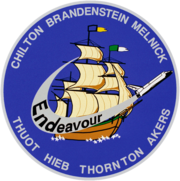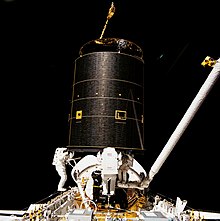STS-49
| COSPAR ID | 1992-026A |
|---|---|
| SATCAT no. | 21963 |
| End of mission | |

 | |
STS-49 was the maiden flight of the Space Shuttle Endeavour. The primary goal of its nine-day mission was to retrieve the Intelsat VI satellite, which failed to leave low earth orbit two years before, attach it to a new upper stage, and relaunch it to its intended geosynchronous orbit. After several attempts, the capture was completed with a three-person extra-vehicular activity, the first time that three people from the same spacecraft walked in space at the same time. It would also stand until STS-102 in 2001 as the longest EVA ever undertaken.
Crew
| Position | Astronaut | |
|---|---|---|
| Commander | Daniel Brandenstein Fourth spaceflight | |
| Pilot | Kevin P. Chilton First spaceflight | |
| Mission Specialist 1 | Pierre J. Thuot Second spaceflight | |
| Mission Specialist 2 | Kathryn C. Thornton Second spaceflight | |
| Mission Specialist 3 | Richard J. Hieb Second spaceflight | |
| Mission Specialist 4 | Thomas D. Akers Second spaceflight | |
| Mission Specialist 5 | Bruce E. Melnick Second spaceflight | |
Mission parameters
- Mass:
- Orbiter landing with payload: 91,214 kg
- Payload: 14,618 kg
- Perigee: 268 km
- Apogee: 341 km
- Inclination: 28.35°
- Period: 90.6 min
Space walks
- Thuot and Hieb - EVA 1
- EVA 1 Start: May 10, 1992 - 20:40 UTC
- EVA 1 End: May 11, - 00:23
- Duration: 3 hours, 43 minutes
- Thuot and Hieb - EVA 2
- EVA 2 Start: May 11, 1992 - 21:05 UTC
- EVA 2 End: May 12, - 02:35 UTC
- Duration: 5 hours, 30 minutes
- Thuot, Hieb and Akers - EVA 3
- EVA 3 Start: May 13, 1992 - 21:17 UTC
- EVA 3 End: May 14, - 05:46 UTC
- Duration: 8 hours, 29 minutes
- Thornton and Akers - EVA 4
- EVA 4 Start: May 14, 1992 - ~21:00 UTC
- EVA 4 End: May 15, ~05:00 UTC
- Duration: 7 hours, 44 minutes
Mission highlights
Intelsat VI (F-3) satellite, stranded in an unusable orbit since launch aboard a Titan vehicle in March 1990, was captured by crewmembers during an EVA (extra-vehicular activity) and equipped with a new perigee kick motor. The Satellite was subsequently released into orbit and the new motor fired to put the spacecraft into a geosynchronous orbit for operational use.

The capture required three EVAs: a planned one by astronaut Thuot and Hieb who were unable to attach a capture bar to the satellite from a position on the RMS; a second unscheduled but identical attempt the following day; and finally an unscheduled but successful hand capture by Thuot, Hieb and Akers as commander Brandenstein delicately maneuvered the orbiter to within a few feet of the 4215 kg communications satellite. An Assembly of Station by EVA Methods (ASEM) structure was erected in the cargo bay by the crew to serve as a platform to aid in the hand capture and subsequent attachment of the capture bar.
A planned EVA also was performed by astronauts Thornton and Akers as part of the ASEM experiment to demonstrate and verify maintenance and assembly capabilities for Space Station Freedom. The ASEM space walk, originally scheduled for two successive days, was cut to one day because of the lengthy Intelsat retrieval operation.
Other "payloads of opportunity" experiments conducted included: Commercial Protein Crystal Growth (CPCG), Ultraviolet Plume Imager (UVPI) and the Air Force Maui Optical Station (AMOS) investigation. Mission was extended two days to complete objectives.
The following records were set during the STS-49 mission:[1]
- First flight of the shuttle Endeavour
- First EVA involving three astronauts.
- First and second longest EVA to date: 8 hours and 29 minutes and 7 hours and 45 minutes.
- First Shuttle mission to feature four EVAs.
- EVA time for a single Shuttle mission: 25 hours and 27 minutes, or 59:23 person hours.
- First Shuttle mission requiring three rendezvous with an orbiting spacecraft.
- First use of a drag chute during a Shuttle landing.
Gallery
-
Thuot during one of the capture attempts
-
Re-deployment of INTELSAT VI
-
ASEM is manipulated by the RMS; Thornton and Akers during EVA 4
See also
- Space science
- Space shuttle
- List of space shuttle missions
- List of human spaceflights chronologically
References
- ^ NASA (2001). "STS-49". National Aeronautics and Space Administration. Retrieved December 7, 2007.
External links




